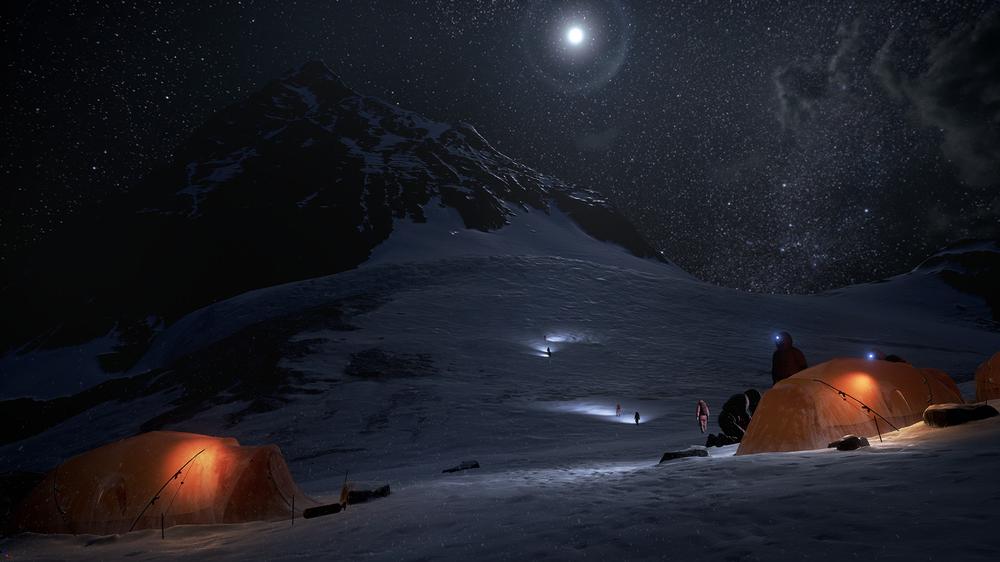
With Everest VR, Sólfar Studios and RVX set a high standard for visual fidelity in virtual reality. Strong visuals don’t always mean high presence, but in this case the stunning landscape they’ve created may be enough.
Without a doubt, Everest VR is not a game. What you get here is a guided tour of what it’s like to climb Mt. Everest from the comfort of your living room. Everest VR does this through a series of vignettes that explore different sections of the climb: Base Camp, Khumbu Icefall, Camp Four, Hillary Step, and the Summit. Each vignette starts with a guided tour over that part of the climb and then transitions you to climbing that section, whether it’s crossing a crevasse on a ladder or making the final climb to the summit.
Use of room scale is exceedingly well done. Each section has you start in a specific location in your VR space that maximizes movement across the diagonal in a way that I haven’t seen before. While you can teleport if you’re confined to standing, to really get a sense of what it’s like to be on the mountain you need to physically conduct the climb. Using ascenders while walking across a horizontal ladder, staring into a deep crevasse below, I felt nervous; the presence was palpable. Walking through the space is key, and the devs nailed that aspect.
Those interactions are bolstered by a visual experience that tops everything else I’ve seen in VR. Emerging from my tent at night, the stars lit up like I have only seen them in the very far north. I was so lost in the beauty that my jaw dropped open in a sense of wonder. After climbing Hillary Step, I found myself mesmerized by the scenery as snow blew over the ridge; exhaustion was evident in the body language of the climber coming up behind me. Afterwards, I looked up some videos of Hillary Step on YouTube; I don’t know if the devs used some form of Digital Terrain Elevation Data for the area or recreated it from photographs and video, but what I saw looked exactly like what I had just climbed.

The visuals are backed up by impressive audio work. One of my favorite moments came from standing next to two other climbers at Camp Four, listening to them discuss their previous attempts. Howling wind helps to create an effective sense of isolation and hardship. The combined impact of the experience left me with the conclusion that climbing Mt. Everest was not a life goal I need to have.
However, there is a huge disconnect in what Everest VR imagines itself to be compared to its implementation. Soon after starting the app, the player is greeted with an extensive tutorial. Some of this is quite useful for those new to VR. In fact, it could be a perfect introduction to HTC Vive controls and teleportation in VR spaces. However, it then goes on to teach you how to put items into your backpack. This is a recipe for disappointment; not only do you not use the ice pick you place into your backpack during the training, you also never pull a single item out of it. The only point of teaching you how to place items into your backpack is so you can load it with items at Base Camp.
And while the room scale space is well used, what you do in that space is undeniably thin. User choice and actions are basically limited to a small set of hand motions to simulate walking or climbing a ladder. While they are effective in increasing presence during the climb, the lack of any real choice of action or equipment stands out like a beacon reminding you that you’re on a tight set of rails through the experience. Interaction with the space is as thin as the Everest air.

So Everest VR winds up having incredible presence in its visuals, motion, and sound, but loses some of the intended impact due to the exceedingly low impact users can have on the environment. Steam reviews rate it as “mixed,” with complaints mostly focusing on the limited gameplay and duration. Game duration can be a touchy subject. While I don’t mind paying for a short experience, you can enjoy all of Everest VR in about an hour, which does seem a bit short for $25. However, if you’re looking to show people just how real the virtual world can appear, I haven’t yet experienced anything with better visuals and sound. Two days after playing, the feeling of being under the stars on the mountain has stuck with me.
You can grab Everest VR on Steam for the HTC Vive.
Note: Everest VR pushes a lot of triangles. I reviewed it on a GTX 980 Ti / Core i7-6700K with default visual settings, though I was able to dial them up to look even more impressive. A copy of Everest VR was provided to conduct this review.


